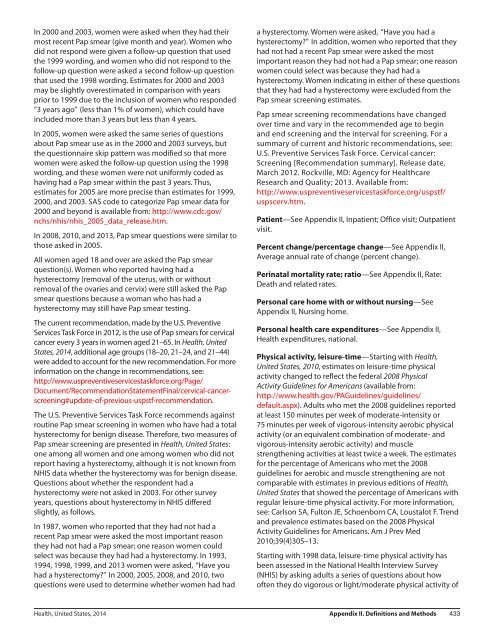hus14
hus14
hus14
Create successful ePaper yourself
Turn your PDF publications into a flip-book with our unique Google optimized e-Paper software.
In 2000 and 2003, women were asked when they had their<br />
most recent Pap smear (give month and year). Women who<br />
did not respond were given a follow-up question that used<br />
the 1999 wording, and women who did not respond to the<br />
follow-up question were asked a second follow-up question<br />
that used the 1998 wording. Estimates for 2000 and 2003<br />
may be slightly overestimated in comparison with years<br />
prior to 1999 due to the inclusion of women who responded<br />
‘‘3 years ago’’ (less than 1% of women), which could have<br />
included more than 3 years but less than 4 years.<br />
In 2005, women were asked the same series of questions<br />
about Pap smear use as in the 2000 and 2003 surveys, but<br />
the questionnaire skip pattern was modified so that more<br />
women were asked the follow-up question using the 1998<br />
wording, and these women were not uniformly coded as<br />
having had a Pap smear within the past 3 years. Thus,<br />
estimates for 2005 are more precise than estimates for 1999,<br />
2000, and 2003. SAS code to categorize Pap smear data for<br />
2000 and beyond is available from: http://www.cdc.gov/<br />
nchs/nhis/nhis_2005_data_release.htm.<br />
In 2008, 2010, and 2013, Pap smear questions were similar to<br />
those asked in 2005.<br />
All women aged 18 and over are asked the Pap smear<br />
question(s). Women who reported having had a<br />
hysterectomy (removal of the uterus, with or without<br />
removal of the ovaries and cervix) were still asked the Pap<br />
smear questions because a woman who has had a<br />
hysterectomy may still have Pap smear testing.<br />
The current recommendation, made by the U.S. Preventive<br />
Services Task Force in 2012, is the use of Pap smears for cervical<br />
cancer every 3 years in women aged 21–65. In Health, United<br />
States, 2014, additional age groups (18–20, 21–24, and 21–44)<br />
were added to account for the new recommendation. For more<br />
information on the change in recommendations, see:<br />
http://www.uspreventiveservicestaskforce.org/Page/<br />
Document/RecommendationStatementFinal/cervical-cancerscreening#update-of-previous-uspstf-recommendation.<br />
The U.S. Preventive Services Task Force recommends against<br />
routine Pap smear screening in women who have had a total<br />
hysterectomy for benign disease. Therefore, two measures of<br />
Pap smear screening are presented in Health, United States:<br />
one among all women and one among women who did not<br />
report having a hysterectomy, although it is not known from<br />
NHIS data whether the hysterectomy was for benign disease.<br />
Questions about whether the respondent had a<br />
hysterectomy were not asked in 2003. For other survey<br />
years, questions about hysterectomy in NHIS differed<br />
slightly, as follows.<br />
In 1987, women who reported that they had not had a<br />
recent Pap smear were asked the most important reason<br />
they had not had a Pap smear; one reason women could<br />
select was because they had had a hysterectomy. In 1993,<br />
1994, 1998, 1999, and 2013 women were asked, ‘‘Have you<br />
had a hysterectomy?’’ In 2000, 2005, 2008, and 2010, two<br />
questions were used to determine whether women had had<br />
a hysterectomy. Women were asked, ‘‘Have you had a<br />
hysterectomy?’’ In addition, women who reported that they<br />
had not had a recent Pap smear were asked the most<br />
important reason they had not had a Pap smear; one reason<br />
women could select was because they had had a<br />
hysterectomy. Women indicating in either of these questions<br />
that they had had a hysterectomy were excluded from the<br />
Pap smear screening estimates.<br />
Pap smear screening recommendations have changed<br />
over time and vary in the recommended age to begin<br />
and end screening and the interval for screening. For a<br />
summary of current and historic recommendations, see:<br />
U.S. Preventive Services Task Force. Cervical cancer:<br />
Screening [Recommendation summary]. Release date,<br />
March 2012. Rockville, MD: Agency for Healthcare<br />
Research and Quality; 2013. Available from:<br />
http://www.uspreventiveservicestaskforce.org/uspstf/<br />
uspscerv.htm.<br />
Patient—See Appendix II, Inpatient; Office visit; Outpatient<br />
visit.<br />
Percent change/percentage change—See Appendix II,<br />
Average annual rate of change (percent change).<br />
Perinatal mortality rate; ratio—See Appendix II, Rate:<br />
Death and related rates.<br />
Personal care home with or without nursing—See<br />
Appendix II, Nursing home.<br />
Personal health care expenditures—See Appendix II,<br />
Health expenditures, national.<br />
Physical activity, leisure-time—Starting with Health,<br />
United States, 2010, estimates on leisure-time physical<br />
activity changed to reflect the federal 2008 Physical<br />
Activity Guidelines for Americans (available from:<br />
http://www.health.gov/PAGuidelines/guidelines/<br />
default.aspx). Adults who met the 2008 guidelines reported<br />
at least 150 minutes per week of moderate-intensity or<br />
75 minutes per week of vigorous-intensity aerobic physical<br />
activity (or an equivalent combination of moderate- and<br />
vigorous-intensity aerobic activity) and muscle<br />
strengthening activities at least twice a week. The estimates<br />
for the percentage of Americans who met the 2008<br />
guidelines for aerobic and muscle strengthening are not<br />
comparable with estimates in previous editions of Health,<br />
United States that showed the percentage of Americans with<br />
regular leisure-time physical activity. For more information,<br />
see: Carlson SA, Fulton JE, Schoenborn CA, Loustalot F. Trend<br />
and prevalence estimates based on the 2008 Physical<br />
Activity Guidelines for Americans. Am J Prev Med<br />
2010;39(4)305–13.<br />
Starting with 1998 data, leisure-time physical activity has<br />
been assessed in the National Health Interview Survey<br />
(NHIS) by asking adults a series of questions about how<br />
often they do vigorous or light/moderate physical activity of<br />
Health, United States, 2014 Appendix II. Definitions and Methods 433


